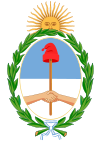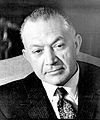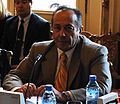- President of Argentina
-
President of the Argentine Nation
Presidente de la Nación Argentina
Presidential StandardStyle Excelentísimo Señor (m) Excelentísima Señora (f) Residence Casa Rosada Term length Four years, renewable once Inaugural holder Bernardino Rivadavia Formation first: 1826 Constitution
current: 1853 Constitution, (reformed 1994).Website Office of the President Argentina 
This article is part of the series:
Politics and government of
Argentina- Constitution
- Government
- President (List)
- Vice President
- National Congress
- Political parties
- Elections: 2007 - 2009 - 2011
- Supreme Court
- Subdivisions
- Foreign relations
- Human rights
The President of the Argentine Nation (Spanish: Presidente de la Nación Argentina), usually known as the President of Argentina, is the head of state of Argentina. Under the national Constitution, the President is also the chief executive of the federal government and Commander-in-Chief of the armed forces.
Through Argentine history, the office of the Head of State has undergone many changes, both in its title as in its features and powers. The current President is Cristina Fernández de Kirchner, who was sworn in on 10 December 2007.
Contents
Features of the office
Requirements
Section 90 of the Argentine Constitution establishes the requirements for becoming the President. The President must be a natural-born citizen of the country, or have been born to Argentine citizens if born abroad. The President must also meet the same requirements as a Senator.
Sections 94 to 98 discuss the electoral requirements. A two-round system is used (Section 94). In order to win the election in the first turn, the winning candidate's party must receive either more than 45 percent of so-called "votos positivos" (Section 97) or at least 40 percent of "votos positivos" and be more than 10 percent ahead of the candidate with the second-highest percentage (Section 98). "Votos positivos" are the sum of all votes validly cast for any of the candidates, leaving out of the count blank and spoilt votes.
If no candidate obtains the necessary votes to win in the first round, then the two most voted candidates compete in the second round, held two weeks later, when the candidate beating by at least one vote becomes elected president.
Term duration
Under the 1994 constitutional amendment, the President serves for four years, with a possibility of immediate reelection for one more term. However, unlike the President of the United States, in Argentina a person may be reelected again after serving for two terms, and staying out of office for the following. So after serving for two consecutive periods, the president is not allowed to run for a third consecutive one, but may return for the two following elections and so on. Naturally there is no limit for a person to be a candidate if he or she does not win the elections.
Also, a person being vice-president for two consecutive periods, or president and then vice-president, or vice-president and then president, is under the same restrictions mentioned above.
Under the constitution of 1853, the President served for six years, with no possibility of consecutive reelection. In 1949, reelection for an indefinite number of terms was allowed (and disabled in 1957). After the 1966 military coup, the rulers promulgated a law establishing terms of four years, terms which were never completed because of political instability.
History of the Office of Head of State
The origins of Argentina as a nation can be traced to 1776, when it was separated by the Spanish King from the existing Viceroyalty of Peru, creating the new Viceroyalty of the Río de la Plata. The Head of State continued to be the King, but was represented locally by the Viceroy. These Viceroys were seldom natives of the country.
By the May Revolution of May 25, 1810, the first Argentine autonomous government, known as the Primera Junta, was formed in Buenos Aires. It was later known as the Junta Grande when representatives from the provinces joined. These early attempts of self-government where succeeded by two Triumvirates and, although the first juntas had presidents, the King of Spain was still regarded as Head of State (as independence had not yet been declared), and the executive power was not still in the hands of a single person.
This power was vested in one man when the position of Supreme Director was created by the 1813 National Assembly. The Supreme Directors became Heads of State after Independence was declared on 9 July 1816, but there were not yet truly a presidential system.
In 1819, Congress declared Independence and composed a Constitution. This established an executive figure, named Supreme Director, who was vested with presidential powers. This constitution gave the Supreme Director the power of appointing Governors of the provinces. Due to political circumstances, this constitution never came into force, and the central power was dissolved, leaving the country a federation of provinces.
A new constitution was drafted in 1826. This constitution was the first to create a President, although this office retained the powers described in the 1819 constitution. This constitution did come into force, resulting in the election of the first President, Bernardino Rivadavia. Because of the Argentina-Brazil War, Rivadavia resigned after a short time, and the office was dissolved shortly after.
A civil war between unitarios (unitarians, i. e. Buenos Aires centralists) and federales (federalists) ensued in the following decades. In this time, there was no central authority, and the closest to that was the Chairman of Foreign Relations, typically the Governor of the Province of Buenos Aires. The last to bear this title was Juan Manuel de Rosas, who in the last years of his governorship was elected Supreme Chief of the Confederation, gaining effective rule of the rest of the country.
In 1852, Rosas was deposed, and a constitutional convention was summoned. This constitution, still in force, established a national federal government, with the office of the President. The term was fixed as six years, with no possibility of reelection. The first elected President under the constitution was Justo José de Urquiza, but Buenos Aires seceded from the Argentine Confederation as the State of Buenos Aires. Bartolomé Mitre was the first president of the unified country, when Buenos Aires rejoined the Confederation. Thus, Rivadavia, Urquiza and Mitre and considered the first presidents of Argentina by different historians: Rivadavia for being the first one to use the title, Urquiza for being the first one to rule under the 1853 constitution, and Mitre for being the first president of Argentina under its current national limits.[1]
In 1930, and again in 1943, 1955, 1962, 1966 and 1976, military coups deposed elected Presidents. In 1966 and 1976, federal government was undertaken by a military junta, where power was shared by the chiefs of the armed forces. In 1962, the President of the Senate ruled, but in the other cases, a military chief assumed the title of President.
It is debatable whether these military presidents can properly be called Presidents, as there are issues with the legitimacy of their governments. The position of the current Argentine government is that military Presidents Leopoldo Fortunato Galtieri and Jorge Rafael Videla were explicitly not legitimate presidents. They, and their immediate successors were denied the right to a presidential pension after the conclusion of their terms. The status of earlier military presidents, however, remains more uncertain.
De facto governments
Following military coups that overthrew the constitutional government was de facto military presidents in 1930, 1943–1944, 1955–1958, 1966–1973 and 1976-1983 that brought in addition to the powers of the president also corresponding to Congress. The subsequent analysis of the validity of their actions led to the subsequent formulation of the doctrine of de facto governments.
That doctrine was nullified by the constitutional reform of 1994 (Article 36), which stated "usurpers" who have stopped the enforcement of the Constitution by acts of force.
Article 29 of the Constitution of 1853 had an article that he considered the sum of public power as 'treason', but was referred to the de jure rulers. For this reason in the constitutional reform of 1994 included Article 36 which says:
Article 36. This Constitution shall rule even when its observance is interrupted by acts of force against the constitutional order and democratic system. These acts shall be irreparably null. Their authors will be subject to the penalty provided in Section 29, disqualified in perpetuity from holding public office and excluded from the benefits of pardon and commutation of sentences.
Who have the same penalties as a result of these actions, assume the powers foreseen for the authorities of this Constitution or those of the provinces, those civil and criminally liable for their actions. The respective actions shall be barred.
All citizens have the right of resistance to those committing acts of force stated in this article.
Also attempt against the democratic system who incurs in serious fraudulent offense against the state that entails enrichment, shall be disqualified for the time specified by law to hold public office.
The Congress shall enact a law on public ethics for the exercise of the function.
In summary the article states:
- Absolute nullity of the acts issued by government installed by force;
- The authors shall be punished as infamous traitors to the Fatherland "
- These crimes are barred and the authors can not receive the benefit of the amnesty;
- Every citizen has the right to resistance against these acts of force.
Complements
The most famous presidential airplane, known as "Tango 01" (by analogy with U.S. Air Force One), owes its name to the denomination of T (pronounced tango in the NATO alphabet) for Transport, which creates an interesting word-game for the Argentine classical Tango music. The presidential helicopter is the usual means of transport between the Quinta de Olivos and the Casa Rosada.
-
La Casa Rosada.
Line of succession
Vice-President
The office of Vice-President was established by the 1853 Constitution for the purpose of providing a succession in case the President is unable to complete its term. The Argentine Constitution (art. 88) entitles the Vice-President to exercise the role and duties of the President, both in the case of a temporary absence and in the case of a permanent absence due to health reasons, death, resignation or removal.
Line of succesion
In the absence of both the President and the Vice-President, the succession is regulated by the Law 20,972 ("Acephaly Law"). It provides that the Executive Power must be temporarily exercised (without assuming the title of President) by the provisional President of the Senate. In its absence, by the President of the Chamber of Deputies. In the absence of both, by the President of the Supreme Court.
In case of the permanent absence of both the President and the Vice-President, due to resignation, death, or removal, the Constitution (art. 88) entitles the National Congress Assembled to select a new President from among the current Senators, Deputies and Governors, within the following two days of the death or resignation of the former President, and to provide him or her with a mandate to call for elections.
Living former presidents
-
Jorge Rafael Videla, 1976-1981 (de facto)
-
Reynaldo Bignone, 1982-1983 (de facto)
-
Carlos Menem, 1989–1999
-
Fernando de la Rúa, 1999–2001
-
Adolfo Rodríguez Saá, 2001
-
Eduardo Duhalde, 2002–2003
Statistics
- President elected to the most terms: Juan Perón, three terms, elected in 1946, 1951 and 1973.
- President who held office for most time: Julio Argentino Roca, for 12 years, in two terms (1880–1886 and 1898–1904).
- President who held office for most time continuously: Carlos Menem, for 10 years and 5 months, in two terms (1989–1999).
- First President elected in the twentieth century: Manuel Quintana, in 1904.
- First President elected in the twentyfirst century: Néstor Carlos Kirchner, in 2003.
- First de facto President: José Félix Uriburu, 1930.
- Last de facto President: Reynaldo Bignone, left in 1983.
- First female President: Isabel Perón (1974–1976).
- First elected female President: Cristina Fernández de Kirchner, in 2007.
- Presidents who died in office: Manuel Quintana (1906), Roque Sáenz Peña (1914) and Juan Perón (1974).
- Presidents who were assassinated: Justo José de Urquiza (1870) and Pedro Eugenio Aramburu (1970), both after concluding their terms.
- Living former presidents as of 27 October 2010: Isabel Perón, Carlos Menem, Fernando de la Rúa, Adolfo Rodríguez Saá and Eduardo Alberto Duhalde, and dictators Roberto M. Levingston, Jorge Videla and Reynaldo Bignone.
See also
- List of Presidents of Argentina
- List of Vice-Presidents of Argentina
- History of Argentina
- Politics of Argentina
Bibliography
- Mendelevich, Pablo (2010). El Final. Buenos Aires: Ediciones B. ISBN 978-987-627-166-0.
References
- ^ Mendelevich, p. 24
External links
- Official site of the Argentine presidency (Spanish)
- ElHistoriador.com.ar (presidents and ministres of the Repúblic Argentine).
- Apodos: la historia también tiene sentido del humor
 Argentina topics
Argentina topicsHistory Timeline · First inhabitants · Governorate · Viceroyalty · War of Independence · Civil War · Generation of '80 · Infamous Decade · Peronism · Dirty War · Falklands War · Trial of the Juntas · December 2001 riotsLaw Constitution · Supreme Court · Civil Code · Law enforcement · Nationality law · Copyright law · Passport · Human rights · LGBT rightsPolitics Government · President · National Congress · Elections · Political parties · Church–state relations · Foreign relationsGeography Regions · Provinces · Departments · Cities · Environment · Climate · Islands · Rivers · Extreme points · National ParksEconomy History · Peso · Central Bank · Banking · Stock Exchange · Foreign trade · Companies · Agriculture · Communications · Transport · TourismMilitary Demographics Culture Architecture (Tallest buildings) · Cinema · Literature · Music · Painting · Comics · Cuisine · Humor · Sports · Radio · Television · NewspapersOther topics Portal · WikiProjectGovernment of Argentina President 
Vice President Chief of the
Cabinet of MinistersMinisters Florencio Randazzo (Interior) · Héctor Timerman (Foreign Relations) · Arturo Puricelli (Defense) · Amado Boudou (Economy) · Julio de Vido (Federal Planning and Public Utilities) · Julio Alak (Justice and Human Rights) · Nilda Garré (Security) · Alberto Sileoni (Education) · Lino Barañao (Science, Technology and Innovative Production) · Carlos Tomada (Labor, Employment and Social Security) · Juan Luis Manzur (Health) · Alicia Kirchner (Social Development) · Débora Giorgi (Industry) · Julián Domínguez (Agriculture) · Carlos Enrique Meyer (Tourism)Heads of state of Argentina May Revolution and Independence War Period
up to Asamblea del Año XIII (1810–1814)Supreme Directors of the United Provinces
of the Río de la Plata (1814–1820)Unitarian Republic – First Presidential Government (1826–1827) Pacto Federal and Argentine Confederation (1827–1862) National Organization – Argentine Republic (1862–1880) Generation of '80 – Oligarchic Republic (1880–1916) First Radical Civic Union terms,
after Universal (Male) Suffrage (1916–1930)Infamous Decade (1930–1943) Revolution of '43 military dictatorships (1943–1946) First Peronist terms (1946–1955) Revolución Libertadora military dictatorships (1955–1958) Fragile civilian governments – Proscription of Peronism (1958–1966) Revolución Argentina military dictatorships (1966–1973) Return of Perón (1973–1976) National Reorganization Process military dictatorships (1976–1983) Return to Democracy (1983–present) Portal:Politics · Politics of Argentina · President of Argentina · List of heads of state of ArgentinaPresidents of South America Sovereign states - Argentina
- Bolivia
- Brazil
- Chile
- Colombia
- Ecuador
- Guyana
- Panama
- Paraguay
- Peru
- Suriname
- Trinidad and Tobago
- Uruguay
- Venezuela
Dependencies and
other territories- Aruba
- Bonaire
- Curaçao
- Falkland Islands
- French Guiana
- Cristina Fernández de Kirchner (Argentina) · Evo Morales (Bolivia) · Dilma Rousseff (Brazil) · Sebastián Piñera (Chile) · Juan Manuel Santos (Colombia) · Rafael Correa (Ecuador) Nicolas Sarkozy (French Guiana) · Bharrat Jagdeo (Guyana) · Fernando Lugo (Paraguay) · Ollanta Humala (Peru) · Dési Bouterse (Suriname) · José Mujica (Uruguay) · Hugo Chávez (Venezuela)
Orders of succession Monarchies Bahrain · Belgium · Bhutan · Brunei · Cambodia · Denmark · Japan · Jordan · Kuwait · Lesotho · Liechtenstein · Luxembourg · Malaysia · Monaco · Morocco · Netherlands · Norway · Oman · Qatar · Saudi Arabia · Spain · Swaziland · Sweden · Thailand · Tonga · United Kingdom and other Commonwealth realmsPresidencies Argentina · Austria · Brazil · Colombia · DR Congo · Dominican Republic · France · Finland · Germany · India · Indonesia · Ireland · Republic of Korea · Mexico · Pakistan · Peru · Philippines · Poland · Portugal · Romania · Russia · Sri Lanka · Republic of China (Taiwan) · United StatesCategories:- Presidents of Argentina
- Government of Argentina
Wikimedia Foundation. 2010.














